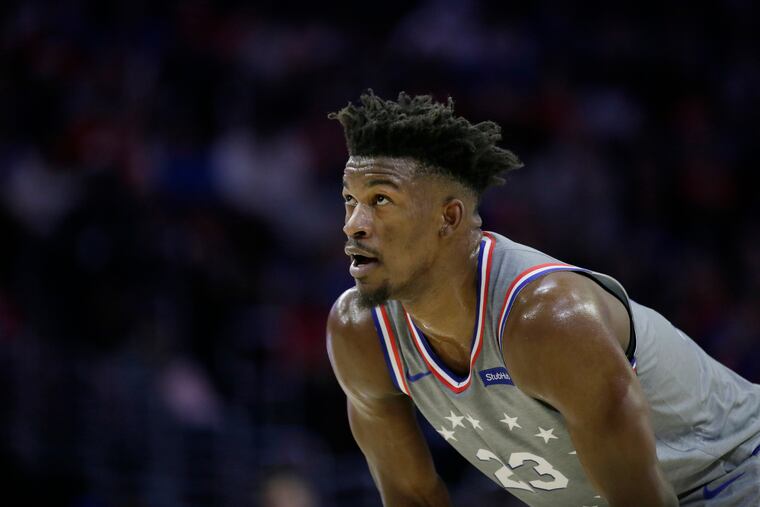Jimmy Butler is showing he can fix the Sixers’ biggest weakness from last year’s playoffs | David Murphy
Robert Covington was a good wing defender, a guy who did a lot of the little things that made the Sixers better as a team. In isolation, though, there is no comparison between him and Butler.

The element that had been missing was here, and the whole building knew it. Four minutes left, good guys down by two, another big lead whittled down to a memory. The ball was in the hands of Donovan Mitchell, a precocious second-year guard who is used to doing what he wants in such situations. Here, he tried the crossover, and then the hesitation, and then, after resetting himself for a third time, he tried to lower his lead shoulder and Eurostep into the paint.
Each time, Jimmy Butler was there, to an extent that the official on his side of the court decided that he could not possibly have been there legally. The whistle might have sent Mitchell to the foul line, but it could not obscure the reality of what had just taken place.
"He wants to stay on people like that," Sixers head coach Brett Brown said later. "He doesn't really want to switch. You respect him. He wants that responsibility."
There have been a lot of different stretches over the last three games when Butler has showcased the reasons why the Sixers decided that they needed him in the fold. None was more glaring than the fourth quarter of their 113-107 win over the Jazz on Friday night. Afterward, most of the focus remained on his performance on the offensive end of the court, and deservedly so. It is an offensive game, increasingly so with each passing year. In Butler, the Sixers now have one of the game's preeminent offensive scorers, a critical component that they found themselves without last postseason, when the Celtics spent five games smothering them in their half-court sets.
You saw it in the remarkable distance he covers with his first step, a glide-like movement impossibly packaged with a quick-twitch explosion. You saw it in the seemingly effortless manner with which he gets to the rim. You saw it in his hang time, in his body control. More than anything, you saw it in the intelligence with which he deploys all of these things, the smooth, efficient body control and the intuitive feel for timing and space.
All of these things have been on display throughout Butler's first few days as a Sixer. There was a moment on Friday night when he pulled up from mid-range and released a high, arcing shot that was clearly off target from the moment the ball left his hands. By the time the ball bounced off of the rim, Butler was there, hovering above the iron to tip in the put-back. So quick was his ability to get to the hoop that he was actually called for basket interference. Think about that. Basket interference on his own jump shot.
The decisive moment came later, on an out-of-bounds play from the sideline. This was another situation where the Sixers struggled mightily against the Celtics. On Friday, with the Sixers clinging to a two-point lead, Ben Simmons knew where he was going before the referee even handed him the ball. Butler exploded past Joe Ingles, hauled in the pass, then rose up from the left block for the game-clinching layup.
"Some guys you can just look at and you already know what's going to happen before it happens," Simmons said later.
Yet for all of the possibilities that Butler's presence opens up for the Sixers on the offensive end of the court, we should not overlook one of the defining moments of last year's playoff loss. When Brown made the decision before Game 4 to keep Robert Covington on the bench for the start of the game, it wasn't because of T.J. McConnell's ability to play above the rim. It was a decision that was made in large part because of the Sixers' inability to prevent the Celtics' penetration, in particular that of point guard Terry Rozier. And it was a decision that should have been on everybody's mind as they watched Butler stay toe-to-toe with Mitchell throughout Friday night's win.
While Mitchell finished the night with a game-high 31 points, 13 of them came in the 8 1/2 minutes that Butler was on the bench, a stretch in which Mitchell shot 6-of-12 from the field. In the nearly 25 minutes that the two players spent on the court together, Mitchell made just seven of his 23 attempts for 17 points. Seventeen points in 25 minutes versus 13 points in 8 1/2 minutes. Seven-of-23 versus 6-of-12.
Covington was a good wing defender, a guy who did a lot of the little things that made the Sixers better as a team. In isolation, though, there is no comparison between him and Butler.
Since news of the trade first broke last weekend, Brown has reminded anybody who will listen that it is going to take some time for the Sixers to learn how to maximize their new rotation. Still, the pieces are there. They might not be a better team now than they were at the end of last season, but they are much better positioned to compete in the games that will ultimately matter. Butler's defense is a big reason why.